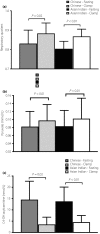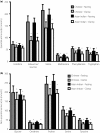Comprehensive assessment of insulin resistance in non-obese Asian Indian and Chinese men
- PMID: 29582571
- PMCID: PMC6215953
- DOI: 10.1111/jdi.12844
Comprehensive assessment of insulin resistance in non-obese Asian Indian and Chinese men
Abstract
Aims/introduction: Indian individuals are more insulin resistant (IR) than Chinese individuals, even among those with a non-obese body mass index (BMI). However, BMI often underestimates body fat in Indian individuals, and it remains unclear whether Indians would remain more IR than Chinese individuals when both BMI and body fat are equally matched.
Materials and methods: Using the hyperinsulinemic-euglycemic clamp with stable-isotope infusion, we comprehensively assessed IR between 13 non-obese Indian men with 13 Chinese men matched for age, BMI and body fat. We further compared the differences in insulin metabolic clearance rate (MCR) between the two groups and its relationship with various metabolic parameters. The response of lipid and amino acid metabolism to insulin stimulation was also evaluated using metabolomic profiling.
Results: The rates of endogenous glucose production during fasting were similar, and endogenous glucose production was completely suppressed during insulin clamp for both ethnic groups. Glucose disappearance during insulin clamp was also similar between the two groups, even after accounting for differences in insulin concentration. Metabolomic profiles of amino acids and various acylcarnitines were similar during both fasting and insulin clamp. However, plasma insulin during clamp was significantly higher in Indian men, indicating that insulin MCR was lower. Insulin MCR correlated significantly with total adiposity and skeletal muscle insulin sensitivity.
Conclusion: When equally matched for body fat, non-obese Indian men had similar skeletal muscle insulin sensitivity and endogenous glucose production to Chinese men. The effects of insulin on lipid and amino acid metabolism were also similar. Low insulin MCR is associated with greater adiposity and lower skeletal muscle insulin sensitivity.
Keywords: Endogenous glucose production; Non-obese Asian Indian; Skeletal muscle insulin sensitivity.
© 2018 The Authors. Journal of Diabetes Investigation published by Asian Association for the Study of Diabetes (AASD) and John Wiley & Sons Australia, Ltd.
Figures




Similar articles
-
Fat distribution and insulin resistance in young adult nonobese Asian Indian women.Metab Syndr Relat Disord. 2012 Oct;10(5):326-30. doi: 10.1089/met.2012.0041. Epub 2012 Jun 29. Metab Syndr Relat Disord. 2012. PMID: 22746275 Free PMC article.
-
Relationship between generalized and upper body obesity to insulin resistance in Asian Indian men.J Clin Endocrinol Metab. 1999 Jul;84(7):2329-35. doi: 10.1210/jcem.84.7.5817. J Clin Endocrinol Metab. 1999. PMID: 10404798
-
Muscle mass and functional correlates of insulin sensitivity in lean young Indian men.Eur J Clin Nutr. 2009 Oct;63(10):1206-12. doi: 10.1038/ejcn.2009.32. Epub 2009 May 27. Eur J Clin Nutr. 2009. PMID: 19471290
-
Lipid accumulation product (LAP) as a potential index to predict risk of insulin resistance in young, non-obese Asian Indian males from Southern India: observations from hyperinsulinemic-euglycemic clamp studies.BMJ Open Diabetes Res Care. 2021 Sep;9(1):e002414. doi: 10.1136/bmjdrc-2021-002414. BMJ Open Diabetes Res Care. 2021. PMID: 34531243 Free PMC article.
-
Ectopic fat, insulin resistance and metabolic disease in non-obese Asians: investigating metabolic gradation.Endocr J. 2019 Jan 28;66(1):1-9. doi: 10.1507/endocrj.EJ18-0435. Epub 2018 Dec 4. Endocr J. 2019. PMID: 30518722 Review.
Cited by
-
Differences in type 2 diabetes risk between East, South, and Southeast Asians living in Singapore: the multi-ethnic cohort.BMJ Open Diabetes Res Care. 2023 Jul;11(4):e003385. doi: 10.1136/bmjdrc-2023-003385. BMJ Open Diabetes Res Care. 2023. PMID: 37507146 Free PMC article.
-
Lessons Learned From Epidemiology of Type 2 Diabetes in South Asians: Kelly West Award Lecture 2024.Diabetes Care. 2025 Feb 1;48(2):153-163. doi: 10.2337/dci24-0046. Diabetes Care. 2025. PMID: 39841965 Free PMC article.
-
Association of triglyceride-glucose-related indices with adverse clinical outcomes in individuals with normal body mass index.Front Cardiovasc Med. 2025 Apr 24;12:1570239. doi: 10.3389/fcvm.2025.1570239. eCollection 2025. Front Cardiovasc Med. 2025. PMID: 40342979 Free PMC article.
-
The impact of obesity-associated glycine deficiency on the elimination of endogenous and exogenous metabolites via the glycine conjugation pathway.Front Endocrinol (Lausanne). 2024 Apr 3;15:1343738. doi: 10.3389/fendo.2024.1343738. eCollection 2024. Front Endocrinol (Lausanne). 2024. PMID: 38633754 Free PMC article.
References
-
- Tai ES, Lim SC, Chew SK, et al Homeostasis model assessment in a population with mixed ethnicity: the 1992 Singapore National Health Survey. Diabetes Res Clin Pract 2000; 49: 159–168. - PubMed
-
- Deurenberg P, Deurenberg‐Yap M, Guricci S. Asians are different from Caucasians and from each other in their body mass index/body fat per cent relationship. Obes Rev 2002; 3: 141–146. - PubMed
-
- Koves TR, Ussher JR, Noland RC, et al Mitochondrial overload and incomplete fatty acid oxidation contribute to skeletal muscle insulin resistance. Cell Metab 2008; 7: 45–56. - PubMed
MeSH terms
Substances
Grants and funding
LinkOut - more resources
Full Text Sources
Other Literature Sources

